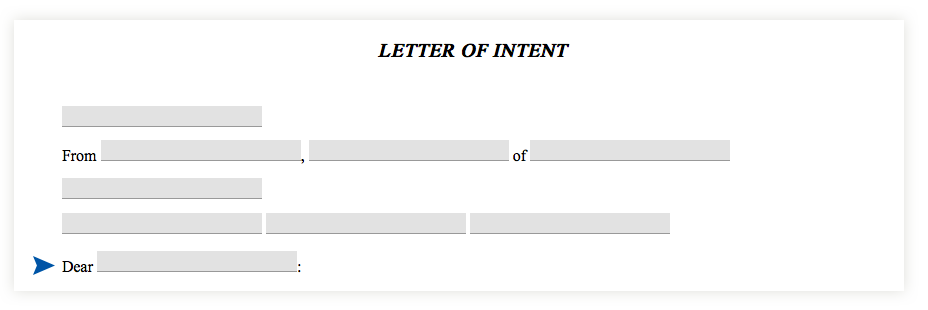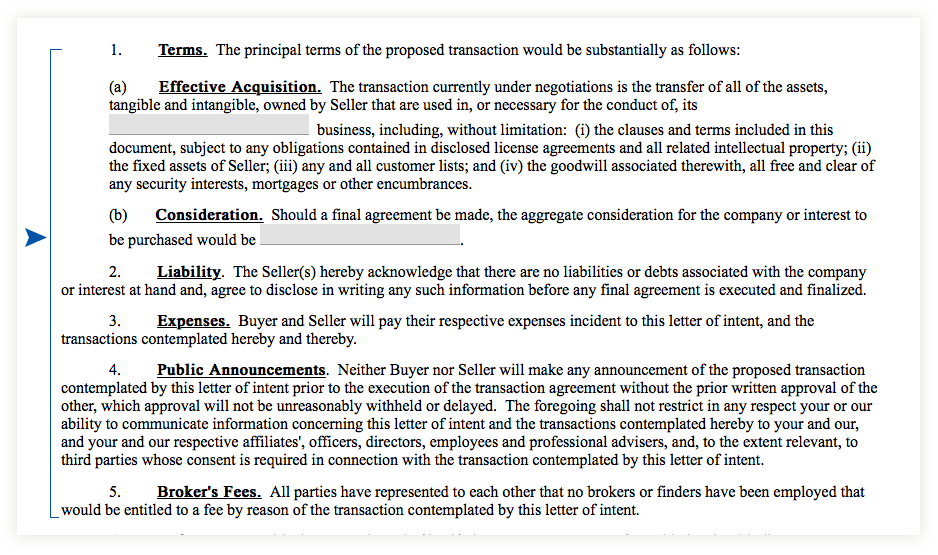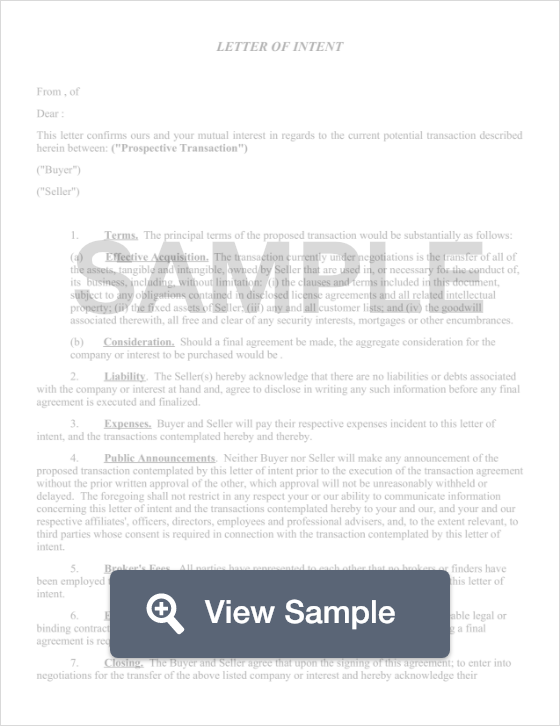What is a Letter of Intent?
A letter of intent (LOI) is a document that someone uses in order to declare their intent to do something, such as make a purchase, apply for a job or education program, or to clarify points in a business transaction. They are written in letter format, and signed by one party (the party writing it). Since it is not a contract, it is not usually a binding agreement.
This document is important because it demonstrates knowledge about the the transaction and how it should be performed. It also shows a respectful interest in the other party and dealing with them in a professional manner while you express your interest in establishing a preliminary agreement.
This letter is a useful way to state your intentions without entering into an agreement for a business deal. Include as much information as possible in your letter to provide the recipient with the details they should know. This will help you to understand the transaction being performed and explain the outcome.
When it comes to small businesses and entrepreneurs, a letter of intent template allows the parties to define their plans and relationships without the high costs of corporate or business lawyers. By using a sample letter of intent, those involved can create one without incurring huge legal costs during the start of the proposed transaction.
While LOIs are not legally binding like a contract, they do constitute “good faith” between the parties to work together on whatever venture is outlined. They are designed to provide security for those involved so they can move forward to finalize the joint venture.
What type of situations would call for a letter of intent template to be used? These letters act as a road map that outline the course of action that will be taken related to the subject matter. This can include business mergers, joint ventures, some graduate school applications, real estate transactions, and more. Mutual fund shareholders may occasionally use one to outline their intent to invest certain amounts of money at specified times. A shareholder might complete the letter of intent template in exchange for reduced charges related to the investment.
Letters of intent cannot be used to force a party to complete a negotiation or move forward with a venture. They are used only to officially declare that a party currently intends to do something.
However, there are occasions where this letter may be binding. If the letter starts specifying actions and promising completion of certain terms, it might become legally binding. In that case, it might begin to resemble a final contract or document, and become binding.
An LOI is often required before businesses spend too much time, effort, or money exploring and ironing out the details of a contract. Often, negotiations require manpower or capital. This can involve surveying, property inspections, researching legal issues, and much more. This document may make the other party feel more comfortable moving forward with these negotiation preparations.
Other Names
A letter of intent may also be referred to as:
- An Intent to Purchase Letter
- Letter of Interest (LOI)
- Terms Sheet
- Memo of Understanding (MOU)
- Assurance Letter
- Framework Letter
Terms to Look Out For
LOIs are meant to included detailed relevant information. So, it’s important that you review the terms. The terms may include (but aren’t limited to):
- Exclusivity (meaning they won’t negotiate with anyone else or that you can’t negotiate with anyone else)
- Price adjustments
- Mention of a purchase price
- Whether the buyer must secure financing
- That the buyer must complete their due diligence
- That the buyer is selling their home
- That there will be an inspection of the property or item being sold
- That regulatory or other required approvals must be obtained (often referenced as third-party approvals)
- Whether there is a confidentiality agreement (often referred to as a non-disclosure agreement)
- Whether there are certain things (often called covenants) that each party must do during negotiations
- Whether there are special terms
Remember, though, while the document should be detailed, including certain dates for performance or guaranteeing specific results by a certain date can make the framework information legally binding
When Should You Use a Letter of Intent?
By FormSwift Editorial Team
August 14, 2018
You should use one in any transaction that involves a purchase before you sign the actual agreement. The most common times it is used in in a purchase of a business, purchase of real property, and the purchase of personal property (such as a car).
Consequences of Not Using One
Depending on the circumstances, you may be unable to close the deal without an LOI. Banks and lenders may require one before they give you a loan to purchase the item. The other party you’re involved with may refuse to do business without one and you'll experience a deal collapse.
Types of Letter of Intent
In this section, we're going to give you specific examples to help guide you through the letter writing process.
Purchase a Business, Real Estate, and General Property
An LOI used to purchase a business, real estate (including commercial property), or general property lists the name, title, and address of both the interested buyer and the seller. It’s also dated. The potential buyer addresses the seller directly.
- The first paragraph identifies the document as a letter of intent to purchase the business, real estate, or general property. If it’s a business, you’d name the business as well as whether you’re purchasing the inventory and assets. For real estate, you’d list the address to the property. For general property, you’d describe the property. The last sentence of the first paragraph should mention that the rest of the letter outlines the proposed main terms.
- The second paragraph would name the business, property, or item again and exactly what the buyer would like to purchase (for example, assets, brand equity, customer lists, mineral rights, etc.). This paragraph should be clearly outlined. If you’re buying a business that has debt, you should mention whether you’re willing to assume the outstanding debt as part of the deal.
- The third paragraph should explain what you’re willing to do to acquire the item. If you’re paying in a lump sum, that should be mentioned. If you’re going to make payments at a certain time, that should be mentioned.
- The fourth paragraph should mention whether the buyer expects the seller to stop looking for other buyers for a certain amount of time so that the buyer may complete their due diligence and move forward with finalizing the agreement.
- The fifth paragraph is extremely important. It should state that the letter should not be construed as an official purchase agreement and that all the terms and conditions of the transaction would be explained in the actual purchase agreement and will be negotiated, agreed to, and executed by both parties.
Before the letter closes, the buyer should state that how long they expect it to take to close the deal.
To Accept a Scholarship
An LOI to accept a scholarship is sent from the student to the organization or institution providing it. It should include the student’s name and address as well as the name and address for the organization providing it. The letter should be dated and should directly address the contact.
- The first paragraph should confirm the student’s intent to accept the scholarship. The type of scholarship should be mentioned as well as the name of the college where it will be used. It should also express appreciation and excitement for the opportunity.
- The second paragraph should request the information the student needs to get ready to make the transition to the school. For example, the student may need information about completing the enrollment process, housing, or a practice schedule for sports-related scholarships. (Sports related scholarships are often referred to as a national letter of intent.)
The letter should end by thanking the contact and expressing excitement about the opportunity.
Grad School
If you plan on submitting an application to attend grad school, you can create an LOI to the school you’re interested in attending. Similar to the other letters we’ve discussed, the letter should be dated and include your information as the sender and the information of the person from the grad school with whom you’ve been in contact. It may be a requirement to submit an LOI along with your application materials.
- The first paragraph should inform the recipient that you’ve submitted your application for the graduate program. It should also list which program you’ve applied to enter and when you plan to start. You should close the first paragraph by asking the recipient to consider your application.
- The second paragraph should provide your contact information (including your phone number) and encourage the recipient to reach out to you if they have any questions.
You should close by thanking the recipient for their time and consideration.
Intent for Acquisition
An intent for acquisition has the same basic components with the name and address of the sender and recipient. It also has the date. While it’s very similar to an LOI to purchase a business, it’s different in the sense that it may be marked as confidential.
These are often a bit longer than an LOI to purchase a business. It may include the basic terms as well as a non-binding statement of understanding and agreements of the parties regarding the procedures for negotiation and preparation of the definitive agreements.
How to Write a Letter of Intent
Now that you’re familiar with the basics of an LOI and its most common uses, let’s look at how to write one.
Before You Write
Before you write your letter, make sure that you understand the purpose of your letter. You should also make sure that you have the appropriate contact information for the recipient. Also, it never hurts to review a template for the type of LOI you’re drafting. Remember, it’s fine to provide detailed information, but don’t use specific dates related to performance or you could go from non-binding to binding.
Step-by-Step Instructions


Determine the best greeting. Don’t be too informal. Use the name of your contact if you have it. The most common greeting is “Dear Mr. / Ms. Last Name.” If they have a professional title such as Doctor, Professor, or Coach, you should use their title instead of Mr. / Ms.
Write the body. The first paragraph should explain the reason you’re sending the letter of intent. If you’re buying a business, real estate, or other item, you should have a transition sentence that tells the reader that your next paragraph will begin explaining the proposed terms of the purchase. If you’re accepting a scholarship, you should express your excitement in a way that is professional and appropriate.

Subsequent paragraphs should explain the terms and what you’re willing to pay and how you’re willing to pay. For students accepting scholarships, you should make sure that you ask your contact to send you any information that you may need to further the process.

Before you close, you should state whether you expect that the other party stop looking for buyers so that you have the time necessary to complete your due diligence tasks to begin finalization of the agreement.

Finally, you should have a paragraph that states that the letter does not represent a purchase agreement.

Use a respectful closing. The most commonly used closing is “Sincerely” and the name of the person sending the letter.
Once It’s Completed
Make sure that you read over the letter before you send it. If you’re unsure if your writing is unclear, ask a trusted colleague or friend to read over it. Do not send it until you’ve thoroughly reviewed it for typos and grammatical errors. This is a professional letter and you should do your very best to ensure it reads as one. Make a copy of it for your records.
Tips for Writing
- Make sure that you have the proper spelling of the name (and position) of the intended recipient.
- Double check that the address you plan to use is correct.
- Remember to include the date that you’re writing the letter.
- Use a professional opening greeting.
- Be clear in your terms.
- Use a professional closing.
- Re-read the document for typos and grammatical errors before you send it.
Download a PDF or Word Template
Letter of Intent
A letter of intent is a document that can be used by professionals in any industry or by individuals. The purpose of a letter of intent is to simply explain the intentions of the person who is writing the letter.
 Read More
Read More
Business Plan
Business plans are sectioned off in order to help business owners explain how they plan to meet certain goals that they've set for their business. A business plan can also be used to discuss your financial projections and how you plan to meet those numbers.
 Read More
Read More
Non-Disclosure Agreement
A non-disclosure agreement is used to protect legitimate business secrets. When an employee or contractor signs a non-disclosure agreement, they are legally bound to keep certain knowledge private for a specified amount of time after they've left their position.
 Read More
Read More
Guardianship Forms
Guardianship offers legal protection for a named care provider in the event of taking significant decisions on behalf of a child or vulnerable adult e.g. for medical treatments.
 Read More
Read More

